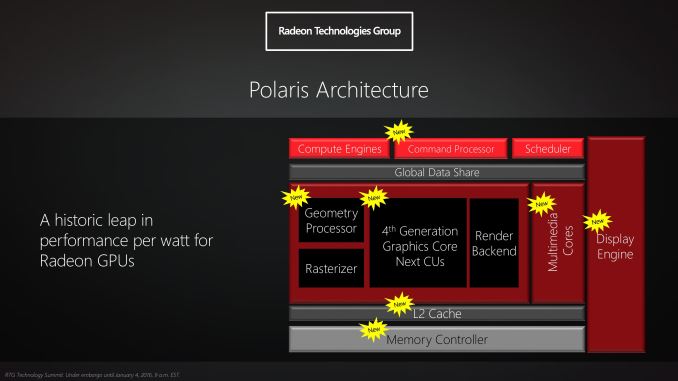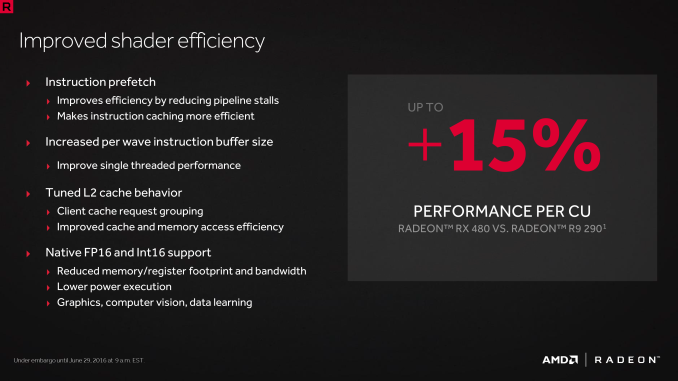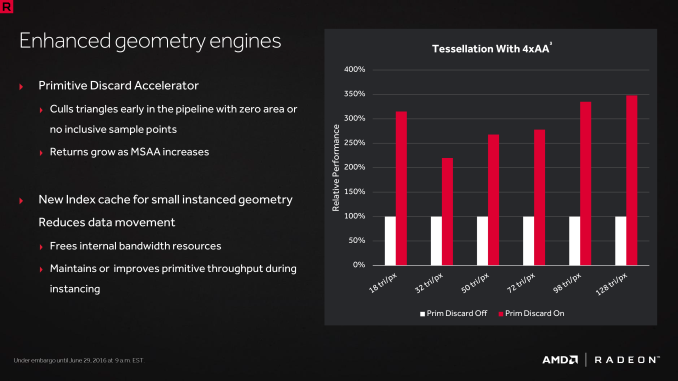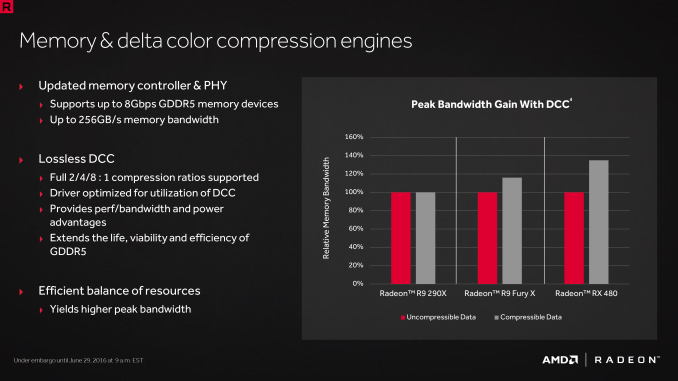The AMD Radeon RX 480 Preview: Polaris Makes Its Mainstream Mark
by Ryan Smith on June 29, 2016 9:00 AM ESTThe Polaris Architecture: In Brief
For today’s preview I’m going to quickly hit the highlights of the Polaris architecture.
In their announcement of the architecture this year, AMD laid out a basic overview of what components of the GPU would see major updates with Polaris. Polaris is not a complete overhaul of past AMD designs, but AMD has combined targeted performance upgrades with a chip-wide energy efficiency upgrade. As a result Polaris is a mix of old and new, and a lot more efficient in the process.
At its heart, Polaris is based on AMD’s 4th generation Graphics Core Next architecture (GCN 4). GCN 4 is not significantly different than GCN 1.2 (Tonga/Fiji), and in fact GCN 4’s ISA is identical to that of GCN 1.2’s. So everything we see here today comes not from broad, architectural changes, but from low-level microarchitectural changes that improve how instructions execute under the hood.
Overall AMD is claiming that GCN 4 (via RX 480) offers a 15% improvement in shader efficiency over GCN 1.1 (R9 290). This comes from two changes; instruction prefetching and a larger instruction buffer. In the case of the former, GCN 4 can, with the driver’s assistance, attempt to pre-fetch future instructions, something GCN 1.x could not do. When done correctly, this reduces/eliminates the need for a wave to stall to wait on an instruction fetch, keeping the CU fed and active more often. Meanwhile the per-wave instruction buffer (which is separate from the register file) has been increased from 12 DWORDs to 16 DWORDs, allowing more instructions to be buffered and, according to AMD, improving single-threaded performance.
Outside of the shader cores themselves, AMD has also made enhancements to the graphics front-end for Polaris. AMD’s latest architecture integrates what AMD calls a Primative Discard Accelerator. True to its name, the job of the discard accelerator is to remove (cull) triangles that are too small to be used, and to do so early enough in the rendering pipeline that the rest of the GPU is spared from having to deal with these unnecessary triangles. Degenerate triangles are culled before they even hit the vertex shader, while small triangles culled a bit later, after the vertex shader but before they hit the rasterizer. There’s no visual quality impact to this (only triangles that can’t be seen/rendered are culled), and as claimed by AMD, the benefits of the discard accelerator increase with MSAA levels, as MSAA otherwise exacerbates the small triangle problem.
Along these lines, Polaris also implements a new index cache, again meant to improve geometry performance. The index cache is designed specifically to accelerate geometry instancing performance, allowing small instanced geometry to stay close by in the cache, avoiding the power and bandwidth costs of shuffling this data around to other caches and VRAM.
Finally, at the back-end of the GPU, the ROP/L2/Memory controller partitions have also received their own updates. Chief among these is that Polaris implements the next generation of AMD’s delta color compression technology, which uses pattern matching to reduce the size and resulting memory bandwidth needs of frame buffers and render targets. As a result of this compression, color compression results in a de facto increase in available memory bandwidth and decrease in power consumption, at least so long as buffer is compressible. With Polaris, AMD supports a larger pattern library to better compress more buffers more often, improving on GCN 1.2 color compression by around 17%.
Otherwise we’ve already covered the increased L2 cache size, which is now at 2MB. Paired with this is AMD’s latest generation memory controller, which can now officially go to 8Gbps, and even a bit more than that when oveclocking.














449 Comments
View All Comments
akamateau - Wednesday, June 29, 2016 - link
Hardly!!!2 RX 480 in CROSSFIRE mode outperforms GTX 1080 for $200 less!!
NVidia F-Ked up.
BUY AMERICAN!!
TheinsanegamerN - Thursday, June 30, 2016 - link
Only if crossfire workes at 100% which is a big IF, and even then it will be drawing twice the power of a 1080 and putting out way more heat, while barely performing any better.Yeah no thanks.
akamateau - Wednesday, June 29, 2016 - link
Hardly!!!2 RX 480 8gb outperforms GTX 1080 for $200.00 less.
rtflol
BUY AMERICAN!!
WhisperingEye - Thursday, June 30, 2016 - link
Nvidia is an American company. So is AMD. Not that difficult to do if you're in the market for a discreet GPU. You come across as a moron, and like a moron, you'll pass over this criticism and continue whatever quest you're on.Einy0 - Wednesday, June 29, 2016 - link
Yup a massive mess up, $100 less than my GTX 970 for the same performance level. The mainstream price points are where the money is made everyone knows that... They will sell tons of these. The only question is how will the GTX 1060 stack up and what price will it be?fanofanand - Thursday, June 30, 2016 - link
There is more to an architecture than CU's, GCN 4 brings a few new technologies your 970 don't have.TheinsanegamerN - Thursday, June 30, 2016 - link
You mean stupid high power consumption for a 14nm card and high heat levels? Such amazing features.As far as DX12 and async are concerned, they will not save AMD. AMD needs to stop relying on magic bullets and actually release competitive hardware first.
fanofanand - Friday, July 1, 2016 - link
A couple of % in certain games is "stupid high power consumption"? I see you have tied your livelihood to Nvidia's success but whoa!AbbieHoffman - Wednesday, June 29, 2016 - link
This is a 80 series card! And it is much faster than the 380 it's replacing. Why do you have to explain everything to people nowadays? I swear anyone born after 1987 would have been considered legally retarded in the 1980's! Thank god for fascist political correctness hu? Your minimally exceptional!TheinsanegamerN - Thursday, June 30, 2016 - link
And it matches a 2 year old 28nm card. How amazing.The 1060 will crush this thing.